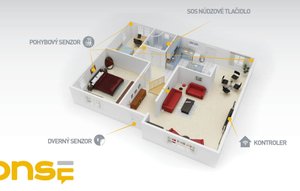Connecting electronic devices to the Internet will simplify daily decisions
This is how the Internet of Things (IoT) works.
A few years ago, we had phones that were not smart. We were able to contact easily by phone or SMS. With the introduction of the iPhone in 2007 came a change in the market. Mobile device manufacturers began offering their own smartphones, and the phone ceased to be used only for telephony and SMS. Today, watching videos, listening to music and reading the latest news on the phone is a common part of our activities. Imagine how many new options will open if we connect all our home electronics to the Internet. In a moment, we can find out what food to buy in the refrigerator, set the thermostat before coming home, or check out what our dog is doing when it is home alone. This is how the Internet of Things (IoT) works. Connect all electronic devices – “things” – to the Internet and turn them into smart devices capable of receiving, sending, and processing information. This information will help make better decisions. This benefit will bring many benefits not only to households but also to businesses.
Various devices are currently available on the market, such as intelligent security cameras that can distinguish a person, electronic locks that can be unlocked by a smartphone, lights that can be controlled by a voice assistant or thermostats. Connecting other devices to the Internet will create an ecosystem that will bring many new benefits and improve everyday life.
Smart home
Imagine that it is a dark winter morning and you get up to work. Your alarm will ring, the low beam will light, your coffee machine will start, your favorite music will start playing gently, and the frozen car you parked outside will start heating. This will certainly facilitate morning waking up. So how does it work? All these devices are connected to the Internet and together with other electronics create a smart home. The whole household is centrally controlled by a control unit, which can be a smartphone. You create a morning routine on your smartphone – actions that automatically run when the alarm rings in the morning. It doesn’t have to be just getting up in the morning. On the way from work, you tell your phone that you are on your way home and it will automatically raise the temperature on the thermostat, so the house is ideally heated when you arrive home. He also finds out what kind of food is missing in the refrigerator and creates a shopping list to stop by the store.
There are many different smart devices. Among the biggest players in the smart home electronics market are well-known technology giants. Nestled by Google as the startup of smart thermostats, Alphabet-owned Nest has expanded its portfolio to offer security cameras, smoke alarms and a host of other smart home devices, most of which are integrated into the Google ecosystem and include a Google voice assistant. Another company is Amazon. Its key product is Alexa voice assist loudspeakers, which serve as a hub for IoT devices in the home. Many other manufacturers offer electronics that support Alex, such as Nest or Philips. Philips was one of the first companies to bring smart lighting to the market. Their luminaires allow you to adjust the intensity, color, light switching times and other parameters while being compatible with Google, Apple and Amazon smart home systems.
Communication between smart devices in the home is done by using protocols. They talk about the way they send a signal to each other – e.g. turn on the light. These protocols are either open, meaning that each manufacturer has access to the protocol – such as Z-wave, or there are private ones that only certain equipment manufacturers have access to. There are several types of IoT devices. The simplest of them are relatively cheap, easy to install, but cannot be extended with additional devices. This can be an issue when you have several at your home. Every single device requires that you have a separate app installed on your phone. As a result, you may need to switch between applications to control devices. This is not very effective when you have multiple devices.
The second option is to buy devices that communicate with the central unit via the above-mentioned protocols hub that just plugs into the power and router. This allows you to control the entire system from one location. For example, the hub may be a loudspeaker with an integrated voice assistant. A separate category is the Apple Home Kit. In this case, just connect the smart device to the Apple device and it serves as a hub. Not all smart home devices are supported – note that a specific device is marked with the “Works with Apple HomeKit” symbol.
If you want a truly functional smart home, you need to make sure that all devices support the same protocol, or they are compatible with the control unit – whether it is a smartphone or a speaker with a voice assistant.
Interested in this article? You may also be interested in the Cloud & collaboration series: Digitization facilitates team collaboration.
Mohlo by vás zaujať
It has made its breakthrough in Canada and delivers solutions to international organizations.
Aliter Technologies is developing its own senior monitoring system. The idea arose in the head of Aliter Technologies CEO Peter Dostál. He decided ...
About the return of the airship era with our Chairman of the Board Pavol Gálik for Forbes magazine.
Did you know that an average office worker receives an average of 120 e-mails a day and sends 40? * Exchange of information by mail is still the mo...




